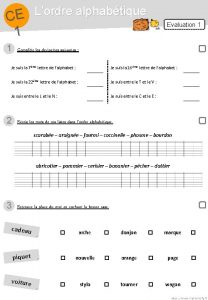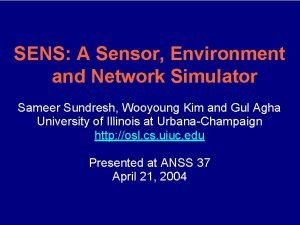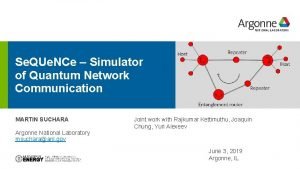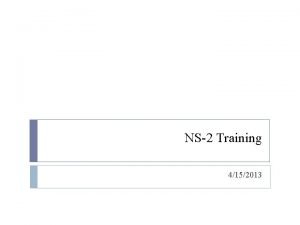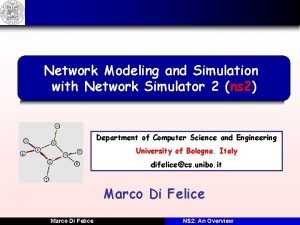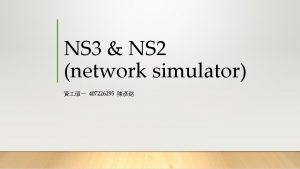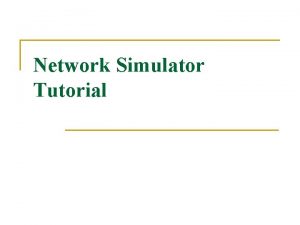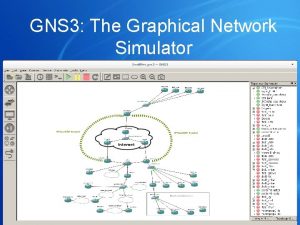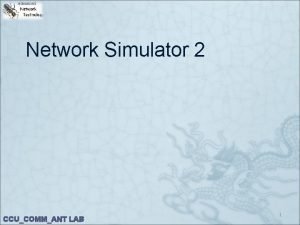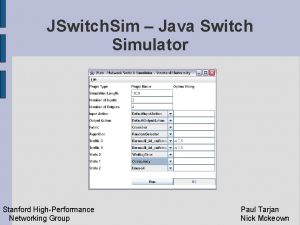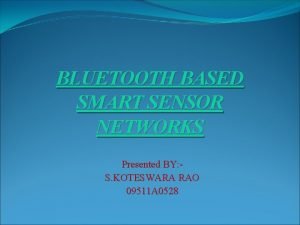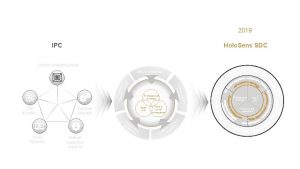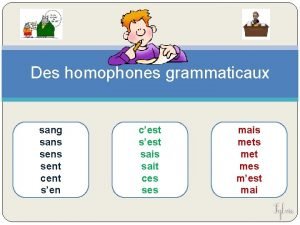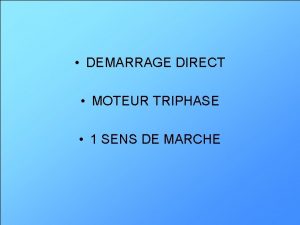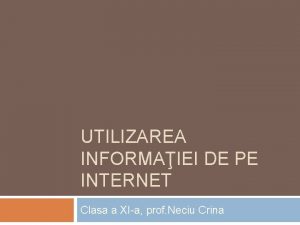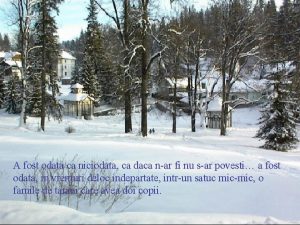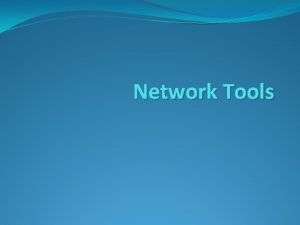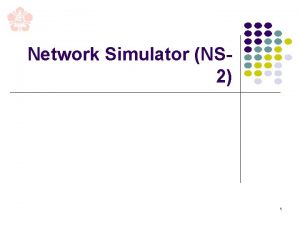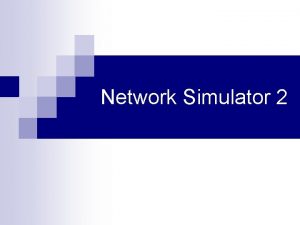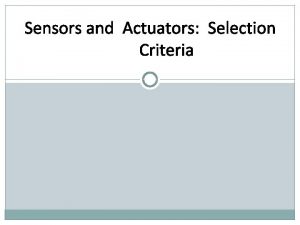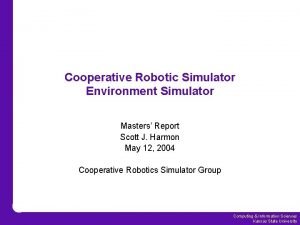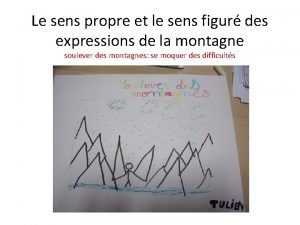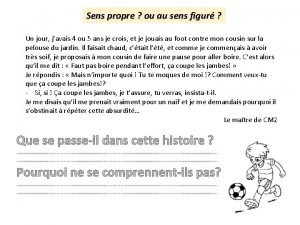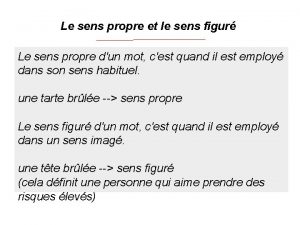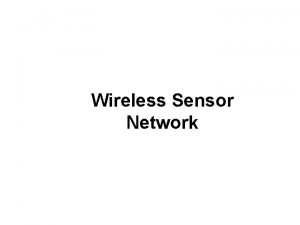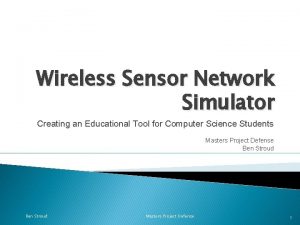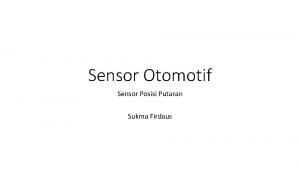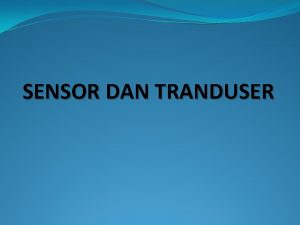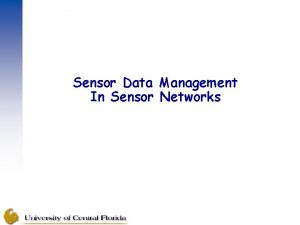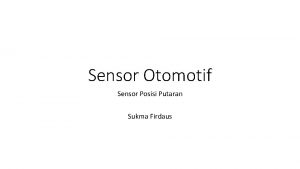SENS A Sensor Environment and Network Simulator Sameer




























- Slides: 28

SENS: A Sensor, Environment and Network Simulator Sameer Sundresh, Wooyoung Kim and Gul Agha University of Illinois at Urbana-Champaign http: //osl. cs. uiuc. edu Presented at ANSS 37 April 21, 2004

What is a Sensor Network? ● Many simple nodes with sensors deployed throughout an environment. – Determination of sensor positions (localization) – Cooperative target identification & tracking – Indoor or outdoor environment monitoring – Civil structural health monitoring (SHM)

Example: Localization Experiment

Example: Structural Health Monitoring Accelerometer board prototype, Ruiz-Sandoval, Nagayama & Spencer, Civil E. , U. Illinois Urbana-Champaign Model bridge with attached wireless sensors, B. F. Spencer’s Lab, Civil E. , U. Illinois U-C Semi-active Hydraulic Damper (SHD), Kajima Corporation, Japan

Characteristics of Sensor Networks ● Errors are common. – Wireless communication – Noisy measurements – Node failures are to be expected ● Network interacts heavily with environment. ● Highly constrained nodes. – e. g. 4 k RAM, 2 AA batteries, 20 msg/s radio ● Must operate for months, little supervision. ● Experiments are time- and space-intensive.

Related Work ● Custom application-specific simulators ● Network simulators – ● Sensor network wireless protocol simulators – ● UCLA Sensor. Sim, Georgia. Tech Sensor. Sim. II Sensor node simulators – ● OPNET, ns-2, Monarch (based on ns-2), Glo. Mo. Sim TOSSIM (for Tiny. OS), TOSSF (based on SWAN) Application-oriented simulators – SENS, Siesta, Em. Star

Simulator Structure Simulator Deployed Network Simulation Controller Node sense/actuate Application Node … Application msg Network messages Node Network Physical sense/actuate Node Environment Physical Environment Node SENS is composed of several concurrently interacting components modeled as actors.

Simulator Components ● ● ● Application – sense/actuate interface – message send/receive interface Physical – handles sense/actuate together with Environment – maintains radio & sensor neighbor sets – computes power usage (based on actuate requests to enable/disable simulated hardware) Network – handles send/receive – several interchangeable implementations

Simple Application #include "System/Sim. h" #include "Interfaces/Physical. Messages. h" // Message type definitions. MESSAGE_TYPE(App. Mesg, int); // Application to be simulated on a node. class Simple. Application: public Application { public: Simple. Application(Sim. Controller *sc, node_id id_, vector<string> *args) : Application(sc, id_) { schedule(new App. Mesg(77), 0. 5); // Send message to self. register. Handler(&Simple. Application: : on. App. Mesg); register. Handler(&Simple. Application: : on. Sensor. Value); } // Message handlers. void on. App. Mesg(App. Mesg *) { cout << "I'm not really listening. " << get. Time() << endl; send(new App. Mesg(77), 0. 3); // Radio neighborhood broadcast. } void on. Sensor. Value(Sensor. Value *sv) { cout << get. Time() << " SA " << id << " sensed something " << endl; } }; // Add Simple. Application to the Component. Registry so it is instantiable from config files. static Register. Application<Simple. Application> re_app("Simple. Application");

Network Components Trade off simulation efficiency and accuracy ● ● ● Simple. Network: immediate, guaranteed delivery to all neighbors within range. Prob. Lossy. Network: probabilistic delivery and delay; delivery probabilities can optionally decrease under heavy traffic. Collision. Lossy. Network: calculates collisions at receiving end based on message overlap and relative signal strengths; selectable interval size.

Environment Simulation ● Environment is divided into tiles with different signal propagation characteristics. – ● Based on experimental measurements. Each sensor is located on one tile.

Environment Simulation ● Environment is divided into tiles with different signal propagation characteristics. – ● Based on experimental measurements. Each sensor is located on one tile. Maximum range cut-off Sound muffled by grass Echo “Beep!”

Circular Wave Propagation 2 3 Tile (x, y) θ 23 θ 12 Source 4 1

Circular Wave Propagation 3 f(0) g(1) 2 g(0. 5) g(0) f(0. 5) θ 23 θ 12 Source f(1) 4 Tile (x, y) 1

Measurement and Attenuation ● ● Must translate total energy passing through a tile to energy of the signal received by a sensor. – Can use f to calculate energy density. – Else divide total energy by max. arc length, approx. by |sinθ|+|cosθ|. Circular waves = 2 -D = 1/r – ● Simulate 3 -D = 1/r 2 by propagating sqrt(energy) To simulate attenuation A observed by real sensors, apply M-1(A(M(e))).

Simulation Parameters Determines behavior of nodes and signals. Can be adjusted for other scenarios.

Observed Mica-2 Radio Range (sketch) 40% signal strength variation with angle Mica-2

Ranging: Simulation vs. Experiment ● Wall effects evident. ● Similar behavior. ● Experiment was separate from calibration. gras s concrete 3 m tall, 2/3 m thick brick wall

Simplified Localization Example ● ● Typical sensor data is location-dependent, hence localization is a necessary service. Anchor nodes know their locations. Perform triangulation using ranging data. Errors due to obstacles (indirect sound paths). – Anchor – Grass or wall – Real vs. localized

Ranging/Localization Complications

Localization vs. Obstacle Density

Non-Anchor Power Usage Simulation Power savings of the black listing policy: If a non-anchor believes it will not make a successful ranging measurement to an anchor, it should not even bother trying.

Simulator Performance n sensor nodes t simulated time Exec. time: O(nt), PC much faster than sensor node Setup time: O(n 2) = # interactions Time to simulate 1000 seconds of simplified localization application.

Ongoing Work ● ● More detailed measurements of node behavior – acoustic ranging in presence of wind, echoes – radio signal strength (e. g. imperfect antenna) – inter- and intra-node timing characteristics Civil structure environment model – Matlab model for environment – Experimental validation of sensor simulations

Ongoing Work ● ● Language/API refinement – deployable sensor node code – automatic annotation of timing and power Use in sensor network service development – localization (acoustic, radio) – Soham Mazumdar, Ashish Agarwal, Indranil Gupta, Wooyoung Kim & Gul Agha, “Fast Range Queries Using Pre-Aggregated In-Network Storage, ” submitted to ACM Sen. Sys 2004. – structural health monitoring – geographic routing

http: //osl. cs. uiuc. edu

End of slides.

A Typical Wireless Sensor Node ● ● ● Mica-2 from Crossbow – 4 MHz 8 -bit Atmel AVR – 4096 bytes RAM – 128 k. B flash for program code – 433 MHz, 32 kb/s radio (~ 20 30 -byte messages/s) – Powered by 2 AA batteries Mica-2 sensor board – 4 k. Hz audio buzzer + microphone + tone detector – 2 -axis accelerometer, 2 -axis magnetometer – light/temperature sensor Currently costs ~$150, eventually under $10.
 Sens propre sens figuré exercices corrigés cm1
Sens propre sens figuré exercices corrigés cm1 Sens simulator
Sens simulator Mahadev konar
Mahadev konar Coffee ground emesis
Coffee ground emesis Sameer awsare kaiser
Sameer awsare kaiser Sameer lapsia
Sameer lapsia Stomodeum
Stomodeum Quantum network simulator
Quantum network simulator Cygwin ns2
Cygwin ns2 Network simulator 2
Network simulator 2 Onap network slicing
Onap network slicing Network slicing simulator
Network slicing simulator Ns3 network simulator
Ns3 network simulator Network simulator 2 tutorial
Network simulator 2 tutorial Gns simulator
Gns simulator Network simulator 2 download
Network simulator 2 download Jswitch
Jswitch Wireless sensor network protocols
Wireless sensor network protocols Bluetooth based smart sensors networks
Bluetooth based smart sensors networks Wireless sensor network ppt
Wireless sensor network ppt Holo sens
Holo sens Cent sang sans sens sent
Cent sang sans sens sent Démarrage direct 1 sens de marche pdf
Démarrage direct 1 sens de marche pdf Comment te sens-tu aujourd'hui in english
Comment te sens-tu aujourd'hui in english Utilizarea informatiei de pe internet
Utilizarea informatiei de pe internet Sens cephalo caudal
Sens cephalo caudal Paralelizm znaczeniowy co to
Paralelizm znaczeniowy co to Fluxurile informationale
Fluxurile informationale Odata ca niciodata sens
Odata ca niciodata sens
